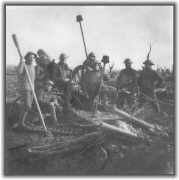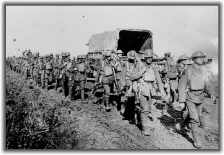
|
On July 1, 1916, in broad daylight, 100,000 soldiers went "over the top" and commenced the attack on the German trenches. Loaded down with 60 pound packs they proceeded slowly against heavy machine gun fire. With 57,000 casualties, the British Army suffered its heaviest single day loss ever. The Newfoundland Regiment, fighting with the 29th British Division (Newfoundland had not yet joined Confederation), was nearly annihilated. From 801 men at the beginning of the battle to only 68 unwounded at the finish, the Newfoundlanders suffered severely.
|






